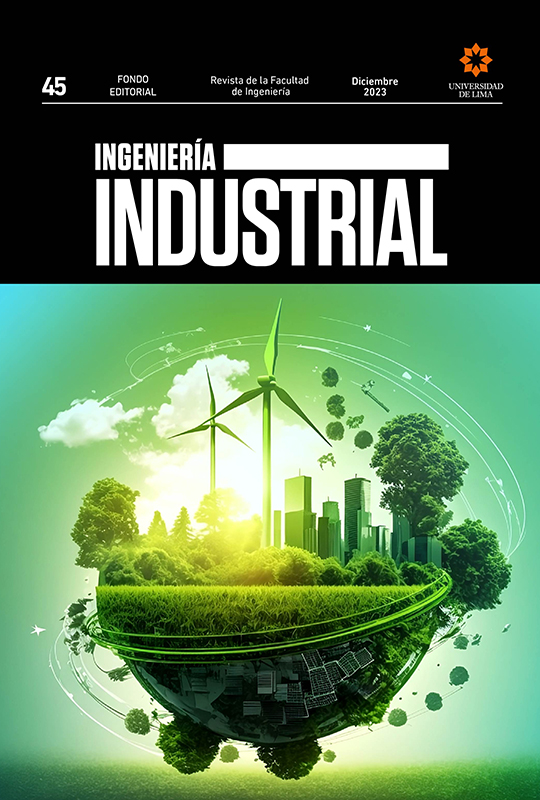Future scenarios of the copper industry. A prospective study of the sector in Peru
DOI:
https://doi.org/10.26439/ing.ind2023.n45.6637Keywords:
copper, copper mining, foresight, variable, scenarioAbstract
Mining has led to multiple social conflicts between communities and companies. However, at the same time, it has been the activity with the greatest contribution to Peru’s gross domestic product for more than a decade, especially copper mining. The importance of copper lies in the fact that it is one of the basic raw materials for the manufacture of products and the expansion of global industries. This research seeks to identify and analyze the possible behavioral scenarios that will support copper mining in the next five years. Foresight (projection of future scenarios), along with the judgment of experts in the field, was used for conducting the research. This methodology employs a non-experimental design and aims at both exploratory and descriptive results. The main findings include an increase in the electricity cost for mining and the continuation of an unfavorable political leadership for its development. It is clear that this issue is taking place in a sensitive context due to the constant social conflicts that occur in favor of the growth of industry. This study will undoubtedly propose solutions to this disparity and will research whether, in any scenario, copper mining and the total population of a copper-rich country can really coexist.
Downloads
References
Andújar-Palao, J. M., Ormachea-Hermoza, R., Ruiz-Ruiz, M. F., & Chirinos Cuadros, C. R. (2021). Minería del cobre en el Perú: análisis de las variables exógenas y endógenas para gestionar su desarrollo. Revista Venezolana de Gerencia, 26(94), 784-801. https://doi.org/10.52080/rvgluzv26n94.18
Behar, O., Peña, R., Kouro, S., Kracht, W., Fuentealba, E., Moran, L., & Sbarbaro, D. (2021). The use of solar energy in the copper mining processes: A comprehensive review. Cleaner Engineering and Technology, 4. https://doi:10.1016/j.clet.2021.100259
Casas Rivera, G. A., & Giraldo Gómez, H. (٢٠١٤). A prioritization technique to identify key parameters that generate large changes in construction projects. Journal of Architecture, 224-235.
Chalapud Narváez, E. D. (2022). The tourism cluster as a regional development mechanism in the municipality of Cordoba - Colombia. FACE: Magazine of the Faculty of Economics and Business Sciences, 22(1), 17-29. https://doi.org/10.24054/face.v22i1.1473
Cornejo, R. (2018). Las cadenas logísticas mineras en el Perú: oportunidades para una explotación más sostenible de los recursos naturales. Comisión Económica para América Latina y el Caribe. https://hdl.handle.net/11362/43222
Dunlap, A. (2019). ‘Agro yes, mine NO!’ The Tía Maria copper mine, state terrorism and social war by every means in the Tambo Valley, Peru. Political Geography, 71, 10-25. https://doi:10.1016/j.polgeo.2019.02.001
Elshkaki, A., Graedel, T. E., Ciacci, L., & Reck, B. K. (2018). Resource demand scenarios for the major metals. Environmental Science and Technology, 52(5), 2491-2497. https://doi:10.1021/acs.est.7b05154
García, M., & Pantigoso, P. (2020). Peru’s mining & metals investment guide 2020/2021. Ministerio de Relaciones Exteriores del Perú. https://cutt.ly/VkVJFoM
Godet, M. (2007). Strategic foresight: problems and methods. Laboratory of Prospective and Strategic Investigation, 20(7), 25-43.
Gonzalez, F. R., Raval, S., Taplin, R., Timms, W., & Hitch, M. (2019). Evaluation of impact of potential extreme rainfall events on mining in Peru. Natural Resources Research, 28(2), 393-408. https://doi:10.1007/s11053-018-9396-1
Guédron, S., Tolu, J., Delaere, C., Sabatier, P., Barre, J., Heredia, C., Brisset, E., Campillo, S., Bindler, R., Fritz, S. C., Baker, P. A., & Amouroux, D. (2021). Reconstructing two millennia of copper and silver metallurgy in the Lake Titicaca region (Bolivia/Peru) using trace metals and lead isotopic composition. Anthropocene, 34. https://doi.org/10.1016/j.ancene.2021.100288
Haas, J., Moreno-Leiva, S., Junne, T., Chen, P. -J., Pamparana, G., Nowak, W., Kracht, W., & Ortiz, J. M. (2020). Copper mining: 100 % solar electricity by 2030? Applied Energy, 262. https://doi:10.1016/j.apenergy.2020.114506
Hanni, M., & Podestá, A. (2019). Trade misinvoicing in copper products: a case study of Chile and Peru. CEPAL Review, 2019(127), 91-108. https://doi.org/10.18356/91479091-en
Instituto de Ingenieros de Minas del Perú. (2021). Anuario Minero. Reporte Estadístico 2021. Ministerio de Energía y Minas. https://www.minem.gob.pe/minem/archivos/file/Mineria/PUBLICACIONES/ANUARIOS/2021/AM2021.pdf
Instituto de Ingenieros de Minas del Perú. (2022). Anuario Minero. Reporte Estadístico 2022. Ministerio de Energía y Minas. https://cdn.www.gob.pe/uploads/document/file/4700376/2022.pdf?v=1689975935
Hunt, C., Romero, J., Jara, J., & Lagos, G. (2021). Copper demand forecasts and predictions of future scarcity. Resources Policy, 73. https://doi:10.1016/j.resourpol.2021.102123
Kuipers, K. J. J., Van Oers, L. F. C. M., Verboon, M., & Van der Voet, E. (2018). Assessing environmental implications associated with global copper demand and supply scenarios from 2010 to 2050. Global Environmental Change, 49, 106-115. https://doi:10.1016/j.gloenvcha.2018.02.008
Landa Arroyo, Y. (2017). Renta extractiva y la minería del cobre en el Perú. Problemas del Desarrollo. Revista Latinoamericana de Economía, 48(189). https://doi.org/10.22201/iiec.20078951e.2017.189.57292
Lagos, G., Peters, D., Lima, M., & Jara, J. J. (2020). Potential copper production through 2035 in Chile. Mineral Economics, 33, 43-56. https://doi.org/10.1007/s13563-020-00227-2
Ruiz Ruiz, M. F. (2017). La perspectiva francesa como estrategia de planeación universitaria: evaluación de la aceptabilidad de su aplicación en una facultad de ingeniería [Tesis doctoral, Pontificia Universidad Católica del Perú]. Repositorio de Tesis PUCP. http://hdl.handle.net/20.500.12404/7929
Schipper, B. W., Lin, H.-C., Meloni, M. A., Wansleeben, K., Heijungs, R., & Van der Voet, E. (2018). Estimating global copper demand until 2100 with regression and stock dynamics. Resources, Conservation and Recycling, 132, 28-36. https://doi.org/10.1016/j.resconrec.2018.01.004
Sverdrup, H. U., Olafsdottir, A. H., & Ragnarsdottir, K. V. (2019). On the long-term sustainability of copper, zinc and lead supply, using a system dynamics model. Resources, Conservation and Recycling: X, 4. https://doi.org/10.1016/j.rcrx.2019.100007
Velasquez Lugo, M. (2020). Uso del análisis estructural para caracterizar variables de calidad educativa en institución de primaria y secundaria venezolana. Educación, 29(56), 170-190. https://doi.org/10.18800/educacion.202001.008
Vidal, O., Rostom, F. Z., François, C., & Giraud, G. (2019). Prey-predator long-term modeling of copper, production, recycling, price, and cost of production. Environmental Science and Technology, 53(19), 11323-11336. https://doi.org/10.1021/acs.est.9b03883



